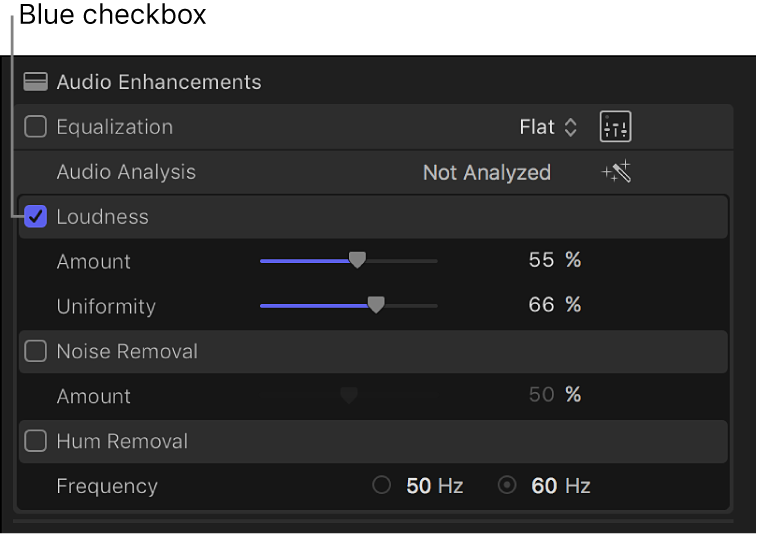Final Cut Pro User Guide
- Welcome
-
- What’s new in Final Cut Pro 10.5.3
- What’s new in Final Cut Pro 10.5
- What’s new in Final Cut Pro 10.4.9
- What’s new in Final Cut Pro 10.4.7
- What’s new in Final Cut Pro 10.4.6
- What’s new in Final Cut Pro 10.4.4
- What’s new in Final Cut Pro 10.4.1
- What’s new in Final Cut Pro 10.4
- What’s new in Final Cut Pro 10.3
- What’s new in Final Cut Pro 10.2
- What’s new in Final Cut Pro 10.1.2
- What’s new in Final Cut Pro 10.1
- What’s new in Final Cut Pro 10.0.6
- What’s new in Final Cut Pro 10.0.3
- What’s new in Final Cut Pro 10.0.1
-
- Intro to effects
-
- Intro to transitions
- How transitions are created
- Add transitions
- Set the default transition
- Delete transitions
- Adjust transitions in the timeline
- Adjust transitions in the inspector and viewer
- Merge jump cuts with the Flow transition
- Adjust transitions with multiple images
- Modify transitions in Motion
-
- Add storylines
- Use the precision editor
- Conform frame sizes and rates
- Use XML to transfer projects
-
- Glossary
- Copyright

Enhance audio in Final Cut Pro
Final Cut Pro includes several powerful tools for automatically analyzing and enhancing the audio in your projects, including:
Loudness: Improves the main audio signal and makes it more uniform.
Background Noise Removal: Reduces background noise.
Hum Removal: Reduces common electrical hum noise at either 50 or 60 Hz.
All enhancements are designed to correct most common audio problems automatically or with minor adjustments.
You can let Final Cut Pro analyze audio and adjust these problems in your audio clips automatically, or you can make manual adjustments in the Audio Enhancements section of the Audio inspector. You can also analyze and fix audio problems when you import a clip. (See Audio analysis options in Final Cut Pro.)
Note: When you import a clip with the “Analyze and fix audio problems” import option selected, only severe audio problems are corrected. If the clip contains moderate problems, these appear in yellow next to Audio Analysis in the Audio Enhancements section of the Audio inspector after the clip is imported. To correct these problems, you need to automatically enhance audio in the Audio inspector.
In Final Cut Pro, select an audio clip or a video clip with audio in the timeline.
Important: Audio enhancement works on the component level, not the clip level. If your audio clip has more than one audio component (for example, a dual mono clip), select an individual component, then proceed with the enhancements.
Do one of the following:
Choose Modify > Auto Enhance Audio (or press Option-Command-A).
Click the Enhancements pop-up menu below the viewer and choose Auto Enhance Audio.

In the Audio inspector, click the Auto Enhance Audio button
 next to Audio Analysis in the Audio Enhancements section.
next to Audio Analysis in the Audio Enhancements section.
If it isn’t already open, open the inspector, then click the Audio button at the top.

In the Audio Enhancements section of the inspector, a green checkmark next to an enhancement indicates that the clip was analyzed and, if necessary, adjusted for that enhancement. A blue checkbox appears next to each enhancement that was turned on to apply a correction. You can turn on additional enhancements by selecting their checkboxes (when an enhancement is turned on, its checkbox is blue).
In the Audio inspector, do any of the following:
Adjust equalization: In the Equalization section, click the Equalization pop-up menu and choose an equalization preset, or click the Controls button to make manual adjustments.
Change loudness settings: Drag the Amount and Uniformity percentage sliders in the Loudness section. The Amount slider increases or decreases the overall loudness (compression) of the clip, and the Uniformity slider increases or decreases the dynamic range affected.
Change the percentage of background noise removal: Drag the Amount slider in the Noise Removal section.
Remove hum: Select either 50 Hz or 60 Hz in the Hum Removal section.

To turn off an enhancement, deselect its checkbox. You may see either of the following indicators:
A yellow warning triangle indicates potential problems.
A red sign indicates severe problems.
If you want a clip to sound like another clip, you can match the audio.